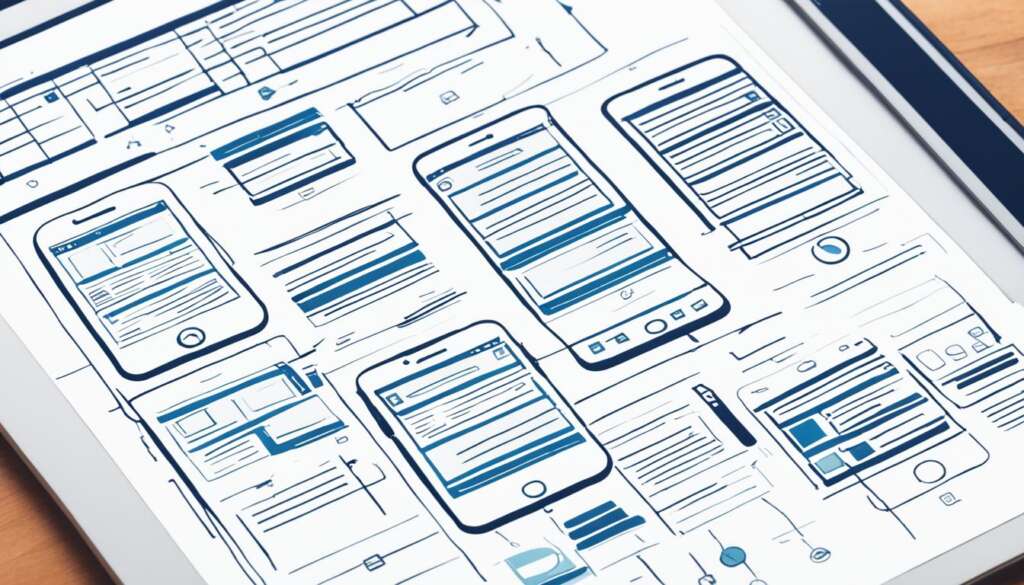Table of Contents
Welcome to our comprehensive guide on the responsive design process. In this article, we will provide you with a step-by-step breakdown of how to create websites and applications that adapt seamlessly to different devices and screen sizes. By implementing the responsive design approach, you can ensure a consistent user experience and optimize your digital strategy for success.
Building a responsive website or application requires a thorough understanding of the responsive design concept. It involves designing user interfaces that can adapt to multiple viewports, ensuring a user-friendly experience across various devices. Originally focused on mobile phones, tablets, and desktops, responsive design now extends to other interfaces such as smartwatches, TVs, and voice user interfaces (VUI). By considering these diverse screens and interfaces, you can create interfaces that cater to a wide range of users.
What is Responsive Design?
Responsive design is a crucial approach in designing user interfaces that can adapt to multiple viewports, ensuring a consistent user experience across devices. By utilizing responsive design, websites and applications are optimized to provide an optimal browsing experience, regardless of the device being used.
Traditionally, responsive web design focused on three primary screens: mobile phones, tablets, and desktops. However, with the ever-growing variety of devices such as smartwatches, TVs, and vehicle dashboards, designers must now consider other screens and interfaces, like voice user interface (VUI).
Understanding responsive design and its technical requirements is crucial before embarking on a project. A comprehensive understanding of responsive design enables designers to create visually appealing and functional UIs that can seamlessly adapt to multiple viewports.
Understanding Responsive Design
Before designers embark on creating responsive user interfaces (UIs), it is crucial to gain a comprehensive understanding of responsive design and the techniques employed by developers. This encompasses various factors, such as determining whether the product utilizes a responsive grid or a fluid grid, identifying the product’s breakpoints, considering the impact of the operating system on the layout, understanding how images and videos are scaled and served, and being familiar with the grid system and CSS framework in use. Proficiency in these technical aspects empowers designers to optimize UIs for diverse devices and screen sizes.
| Responsive Grid | Fluid Grid |
|---|---|
| A responsive grid system is based on predefined breakpoints and adapts the layout based on the screen size. It provides a structured approach to design and ensures consistent visual alignment across different devices. | A fluid grid system allows content to flow and expand or contract based on the available screen space. It offers greater flexibility in accommodating various screen sizes and resolutions. |
- Breakpoints: These are specific screen widths at which the layout of a responsive design changes. By defining breakpoints, designers can optimize the display and user experience for different devices.
- Operating System Impact: Designers need to consider how the operating system of a device may influence the layout and visual presentation of a responsive design. Certain operating systems may have unique design guidelines or restrictions that must be taken into account.
- Scaling and Serving Images and Videos: Effective utilization of responsive design involves considering how images and videos are scaled and served across different devices. Proper optimization ensures quick loading times and a seamless user experience.
- Grid System and CSS Framework: The choice of a grid system and CSS framework has a significant impact on the development and maintenance of a responsive design. Familiarity with these tools enables designers to create visually appealing and efficient UIs.
Understanding these technical aspects of responsive design allows designers to create user interfaces that seamlessly adapt to different devices, providing an optimal user experience. By incorporating responsive grids or fluid grids, implementing breakpoints, considering operating systems, and optimizing the delivery of images and videos, designers can ensure the success of their responsive designs.
Content Strategy Approach
Designing layouts around content is a crucial aspect of the responsive design process. By implementing a well-defined content strategy, designers can create intuitive and visually appealing interfaces that effectively communicate with users across various devices.
An important consideration when designing responsive layouts is maintaining an intuitive hierarchy that guides users through the content. This hierarchy helps users easily navigate the interface, find relevant information, and complete their intended actions. By organizing layouts according to breakpoints, designers can ensure that the content is displayed in a user-friendly manner, regardless of the screen size.
One effective approach is to adopt a mobile-first design strategy. This involves prioritizing the presentation of critical features and user interface components for smaller screens. By focusing on the most essential elements first, designers can optimize the user experience on mobile devices, where space is limited. As the screen size increases, additional non-essential elements can be progressively introduced.
When implementing a mobile-first design, designers must also consider the content that should always be visible on smaller devices. This includes important information, key calls-to-action, and any content that plays a significant role in achieving the website or application’s objectives. Designers can then determine what content can be hidden behind navigational elements such as dropdown menus or accordions, optimizing screen space.
By adopting a content strategy approach and implementing intuitive layouts with a clear hierarchy, designers can create responsive interfaces that offer a seamless user experience across multiple devices and screen sizes.
Examples of Content Prioritization
| Screen Size | Content Prioritization |
|---|---|
| Mobile | Headline, key information, main call-to-action |
| Tablet | Additional supporting information, secondary call-to-action |
| Desktop | Expanded content, tertiary call-to-action |
Responsive Images & Videos
When it comes to responsive design, choosing the right media formats is crucial for optimal performance. Designers and engineers need to collaborate and agree on the appropriate formats and sizes of images and videos for different devices and viewports. By ensuring that assets are prepared correctly, websites and applications can deliver a seamless user experience.
One important consideration for responsive design is the adaptability of media formats like SVG for icons. Scalable Vector Graphics (SVG) can be resized without loss of quality, making them ideal for responsive layouts. By using SVG icons, designers can ensure that icons look crisp and clear on any screen size or resolution.
Another aspect to consider is the impact of typography on responsive layouts. Fonts can play a vital role in the overall aesthetics and readability of a design. Designers should choose fonts that are legible on all devices, especially smaller screens. Ensuring that the typography scales appropriately and remains readable is crucial for maintaining a consistent user experience.
Let’s take a look at a table that summarizes the recommended media formats for responsive images and videos:
| Media Format | Benefits | Best Use Cases |
|---|---|---|
| JPEG | High compression, suitable for photographs | Websites, photo galleries |
| PNG | Lossless compression, supports transparency | Logos, icons, illustrations |
| GIF | Supports animation, limited colors | Simple animations, loading spinners |
| WebP | High compression, supports transparency and animation | Modern browsers, improving performance |
| SVG | Scalable, lossless, supports interactivity | Icons, logos, scalable graphics |
| MP4 | High-quality video, widely supported | Embedded videos, video backgrounds |
| WebM | Open format, high-quality video | Modern browsers, improving performance |
| YouTube Embed | Easy integration, hosting provided | Website content, video sharing |
By considering these media formats and their best use cases, designers can optimize the visual experience and performance of responsive designs. It’s important to choose the right format for each element to ensure that images and videos load quickly and look great on any device.
Now that we’ve explored responsive images and videos, let’s move on to the next section, which focuses on responsive design performance optimization.
Responsive Design Performance Optimization
While developers primarily handle performance optimization, designers play a crucial role in improving the performance of responsive design. By considering factors like system fonts and animations, designers can contribute to a better-performing responsive design.
Using System Fonts
One effective way to optimize performance in responsive design is by utilizing system fonts instead of custom ones. System fonts are pre-installed on devices, which means that there is no need to make additional font requests, resulting in faster loading times.
“Using system fonts instead of custom ones can significantly improve loading times and eliminate the need for additional font requests in responsive design.”
By leveraging system fonts, designers can streamline the loading process and enhance overall performance, providing users with a better experience.
Carefully Managing Animations
While animations can enhance the visual appeal of a website or application, it’s important to exercise caution when implementing them in responsive design. Excessive or poorly optimized animations can negatively impact performance, leading to slow page load times and reduced user engagement.
“Carefully managing animations in responsive design is crucial to ensure they are used sparingly and strategically, optimizing performance without sacrificing visual impact.”
Designers should aim to use animations sparingly and strategically, focusing on key moments or interactions that add value to the user experience. By doing so, designers can strike a balance between engaging visual elements and optimal performance.
Striving for Better Performance
By considering the use of system fonts and carefully managing animations, designers can contribute to creating a high-performing responsive design. Prioritizing performance optimization alongside other design considerations allows for a seamless user experience across different devices and screen sizes.
Remember that collaboration between designers and developers is essential in achieving a well-optimized responsive design. By working together and aligning their strategies, designers and developers can create a website or application that not only looks visually appealing but also performs optimally.
Conclusion
The responsive design process is crucial for creating seamless web experiences across devices. By following the steps outlined in this article, designers can implement best practices to ensure their designs adapt beautifully to different screen sizes and devices. Collaboration between designers and developers plays a significant role throughout the process, fostering a holistic approach and ensuring the final product is optimized for all users.
Utilizing design tools like UXPin Merge can greatly benefit designers by facilitating the prototyping and testing of responsive UIs. These tools enable accurate representation and functionality across various viewports, enhancing the user experience and satisfaction. With the right design tools in their toolkit, designers can streamline their workflows and achieve efficient results.
It is important for designers to stay updated with the latest industry trends and continuously refine their responsive design skills. By incorporating best practices such as mobile-first design, intuitive layouts, and prioritizing content hierarchy, designers can create impactful and user-friendly interfaces. Ultimately, a successful and optimized responsive design requires a collaborative effort and adherence to best practices throughout the entire design process.
FAQ
What is responsive design?
Responsive design is the process of designing user interfaces that can adapt to multiple viewports, providing a consistent user experience across different devices.
What is the aim of responsive design?
The aim of responsive design is to ensure that users have a consistent and optimal user experience, regardless of the device they are using to access a website or application.
What is the difference between a responsive grid and a fluid grid?
A responsive grid uses predetermined breakpoints to adjust the layout of a user interface, while a fluid grid adapts smoothly and proportionally to different screen sizes without specific breakpoints.
What are breakpoints in responsive design?
Breakpoints are specific screen widths at which a responsive design layout changes to accommodate different screen sizes and viewports.
How can mobile-first design help optimize the user experience?
Mobile-first design prioritizes critical features and UI components for smaller screens, ensuring that the most important content is easily accessible and optimized for mobile users.
How should designers prioritize content on smaller devices?
Designers should ensure that content that is always visible on smaller devices is given priority, while less essential content can be hidden behind navigational elements like dropdown menus or accordions.
What should designers consider when selecting media formats for responsive design?
Designers should agree on the formats and sizes of images and videos to be used on different devices and viewports to ensure optimal performance and adaptability.
How can designers contribute to better performance in responsive design?
Designers can contribute to better performance by using system fonts instead of custom ones, carefully managing animations, and considering the impact of typography on responsive layouts.
How can tools like UXPin Merge aid in prototyping and testing responsive UIs?
Tools like UXPin Merge can assist designers in prototyping and testing responsive UIs, ensuring accurate representation and functionality across different viewports.
Why is collaboration between designers and developers crucial in responsive design?
Collaboration between designers and developers is essential to ensure a successful and optimized responsive design, as both parties bring their expertise to create a cohesive and functional user experience.













